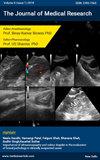Whether serum albumin/leukocyte ratio combined with Go-FAR score more accurately predicts the neurological outcome of patients who suffered cardiac arrest
引用次数: 0
Abstract
Objective: To investigate whether serum albumin/leukocyte ratio combined with good outcome score after resuscitation (GO-FAR score) can improve the prediction of neurological outcomes in patients with cardiac arrest, so that clinical decisions can be made earlier and futile resuscitation can be avoided. Methods:The data of 72 patients with cardiac arrest rescued 2020.01.01-2022.04.30 in the Seventh Affiliated Hospital of Sun Yat-sen University were collected, and the GO-FAR score and albumin/leukocyte ratio of all patients were calculated. The main research outcome was the neurological outcome within one month after cardiac arrest. The brain function performance score (CPC score) was used for assessing neurological outcomes, It was divided into two groups:a good prognosis group (CPC score 1-2) and a poor prognosis group (CPC score 3-5). Multivariate Logistic analysis and ROC curve analysis were performed on the data of the two groups, and conclusions were drawn. Result:Univariate and multivariate analysis found that the albumin/leukocyte ratio and GO-FAR score in the poor prognosis group were lower than those in the good prognosis group, and the difference between the two groups was statistically significant (P < 0.05).The results of ROC curve analysis found that the area under the curve of ALB/WBC, GO-FAR score, and ALB/WBC + GO-FAR score were: 0.782 (95% CI: 0.662 to 0.903), 0.677 (95% CI: 0.493 to 0.862), 0.841 (95% CI: 746-0.936), P < 0.05, and the difference was statistically significant. Malignant tumor, shock rhythm, albumin, and leukocytes were all influencing factors for functional outcomes in patients with cardiac arrest. Conclusion:The combination of GO-FAR score and albumin/leukocyte ratio can better predict neurological outcomes in patients with cardiac arrest, but still cannot make instructions to stop resuscitation. More research is needed to confirm.血清白蛋白/白细胞比值联合Go-FAR评分是否能更准确地预测心脏骤停患者的神经预后
目的:探讨血清白蛋白/白细胞比值结合复苏后良好预后评分(GO-FAR评分)是否能提高对心脏骤停患者神经系统预后的预测,从而尽早做出临床决策,避免无效的复苏。方法:收集中山大学第七附属医院2020.01.01-2022.04.30抢救的72例心脏骤停患者的资料,计算所有患者的GO-FAR评分和白蛋白/白细胞比。主要研究结果为心脏骤停后1个月内的神经学结果。采用脑功能表现评分(CPC评分)评价神经系统预后,分为预后良好组(CPC评分1-2分)和预后差组(CPC评分3-5分)。对两组资料进行多因素Logistic分析和ROC曲线分析,得出结论。结果:单因素及多因素分析发现,预后不良组白蛋白/白细胞比、GO-FAR评分均低于预后良好组,两组差异有统计学意义(P <0.05)。ROC曲线分析结果发现,ALB/WBC、GO-FAR评分、ALB/WBC + GO-FAR评分曲线下面积分别为:0.782 (95% CI: 0.662 ~ 0.903)、0.677 (95% CI: 0.493 ~ 0.862)、0.841 (95% CI: 746 ~ 0.936), P <0.05,差异有统计学意义。恶性肿瘤、休克节律、白蛋白和白细胞都是心脏骤停患者功能结局的影响因素。结论:结合GO-FAR评分和白蛋白/白细胞比值可以较好地预测心脏骤停患者的神经预后,但仍不能指导停止复苏。这需要更多的研究来证实。
本文章由计算机程序翻译,如有差异,请以英文原文为准。
求助全文
约1分钟内获得全文
求助全文

 求助内容:
求助内容: 应助结果提醒方式:
应助结果提醒方式:


